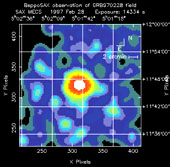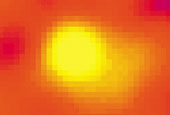|
ERCIM News No.49, April 2002
|
 |
| Figure 1: Gamma-ray burst GRB970228. Beppo-SAX team, Agenzia Spaziale Italiana, ESA. |
 |
| Figure 2: GRB970228 housed in a galaxy? Team of J. van Paradijs, Hubble Space Telescope, NASA. |
Relativistic MHD Computation of Gamma-ray Bursts
by Barry Koren
Gamma ray bursts constitute the most energetic events in the Universe so far. Their nature is still a mystery. Recent observations enable comparison with model computations. CWI develops numerical methods to solve the relativistic equations of magnetohydrodynamics (MHD) underlying such models.
A gamma-ray burst hit the Italian-Dutch Beppo-SAX satellite for about 80 seconds on February 28, 1997 (Figure 1). Its monitor accurately measured the position of the burst, and within eight hours the spacecraft's x-ray telescope found a rapidly fading source of x-rays on the spot. Never before a burst had been pinpointed so accurately and so quickly. Subsequent observation with the powerful Hubble Space Telescope in the optical domain revealed a bright spot surrounded by a somewhat elongated background object (Figure 2). The latter is believed to be a galaxy. If so, it must be near the edge of the observable universe, and the gamma-ray burst represented the most powerful explosion observed thus far. Such bursts emit within the span of minutes or even seconds more energy than the Sun will in its entire life. Since their (accidental) discovery in the late 1960s, their origin and incredible energy remain a mystery. One scenario is a collapsing binary neutron star system, where gravitational energy is converted into kinetic energy of an expanding cloud of protons moving at relativistic speeds. Gamma rays are then generated by electrons accelerated by the intense electromagnetic fields occurring in shock waves. These waves result from collisions inside the proton cloud as well as with the surrounding gas. This scenario with shock waves implies that gamma-ray bursts are followed by long afterglows of x-rays and visible light. The burst of February 1997 provides strong evidence for such a tail.
Since experiments are impossible, insight into the nature of gamma-ray bursts can only be attained by solving the full relativistic equations of magnetohydrodynamics (MHD). At CWI the Computational Fluid Dynamics group addresses this problem, with partners at the University of Utrecht (Astro-Plasmaphysics) and the Institute for Plasma Physics in Rijnhuizen (Numerical Plasma Dynamics). As a first step, a computational method is developed for the relativistic equations of gas dynamics, which form a system of hyperbolic partial differential equations. A tailor-made discretization will take into account the different propagation velocities of rarefaction waves, shock waves, and contact discontinuities. An approximate Riemann-solver will be derived, as well as a staggered-grid approach. These two methods will be tested against a highly relativistic spherical explosion, for which an exact solution exists, thus serving as a severe numerical benchmark. After having passed this test, and a few others, electromagnetic effects will be incorporated and the second step of solving the relativistic MHD equations will be made. This system of equations is still hyperbolic, but its wave patterns are more complex. For its numerical solution approximate Riemann solvers and a staggered-grid approach will be developed as well. CWI's research contribution is crucial for the further development of large-scale computer codes in astrophysics.
Please contact:
Barry Koren, CWI
Tel: +31 20 592 4114
E-mail: Barry.Koren@cwi.nl
http://www.cwi.nl/~barry/
